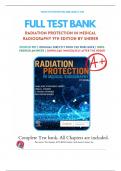MEDCONNOISSEURLIBRARIES.COM
,MEDCONNOISSEURLIBRARIES.COM
,Chapter 01: Introduction to Radiation Protection
Sherer: Radiation Protection in Medical Radiography, 9th Edition
MULTIPLE CHOICE
1. Consequences of ionization in human cells include
1. creation of unstable atoms.
2. production of free electrons.
3. creation of highly reactive free radicals capable of producing substances poisonous to the
cell.
4. creation of new biologic molecules detrimental to the living cell.
5. injury to the cell that may manifest itself as abnormal function or loss of function.
a. 1, 2, and 3 only
b. 2, 3, and 4 only
c. 3, 4, and 5 only
d. 1, 2, 3, 4, and 5
ANS: D
2. Which of the following is a form of radiation that is capable of creating electrically charged
particles by removing orbital electrons from the atom of normal matter through which it
passes?
a. Ionizing radiation
b. Nonionizing radiation
c. Subatomic radiation
d. Ultrasonic radiation
ANS: A
3. Regarding exposure to ionizing radiation, patients who are educated to understand the medical
benefit of an imaging procedure are more likely to
a. assume a small chance of biologic damage but not suppress any radiation phobia
they may have.
b. cancel their scheduled procedure because they are not willing to assume a small
chance of biologic damage.
c. suppress any radiation phobia but not risk a small chance of possible biologic
damage.
d. suppress any radiation phobia and be willing to assume a small chance of possible
biologic damage.
ANS: D
4. The millisievert (mSv) is equal to
a. 1/10 of a sievert.
b. 1/100 of a sievert.
c. 1/1000 of a sievert.
d. 1/10,000 of a sievert.
ANS: C
MEDCONNOISSEURLIBRARIES.COM
, 5. The advantages of the BERT method are
1. it does not imply radiation risk; it is simply a means for comparison.
2. it emphasizes that radiation is an innate part of our environment.
3. it provides an answer that is easy for the patient to comprehend.
a. 1 and 2 only
b. 1 and 3 only
c. 2 and 3 only
d. 1, 2, and 3
ANS: D
6. If a patient asks a radiographer a question about how much radiation he or she will receive
from a specific x-ray procedure, the radiographer can
a. respond by using an estimation based on the comparison of radiation received from
the x-ray to natural background radiation received.
b. avoid the patient’s question by changing the subject.
c. tell the patient that it is unethical to discuss such concerns.
d. refuse to answer the question and recommend that he or she speak with the
referring physician.
ANS: A
7. Why should the selection of technical exposure factors for all medical imaging procedures
always follow ALARA?
a. So that referring physicians ordering imaging procedures do not have to accept
responsibility for patient radiation safety.
b. So that radiographers and radiologists do not have to accept responsibility for
patient radiation safety.
c. Because radiation-induced cancer does not appear to have a dose level below
which individuals would have no chance of developing this disease.
d. Because radiation-induced cancer does have a dose level at which individuals
would have a chance of developing this disease.
ANS: C
8. The cardinal principles of radiation protection include which of the following?
1. Time
2. Distance
3. Shielding
a. 1 only
b. 2 only
c. 3 only
d. 1, 2, and 3
ANS: D
9. In a hospital setting, which of the following professionals is expressly charged by the hospital
administration with being directly responsible for the execution, enforcement, and
maintenance of the ALARA program?
a. Assistant administrator of the facility
b. Chief of staff
MEDCONNOISSEURLIBRARIES.COM




